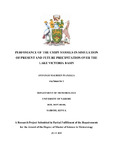Perfomance of the cmip5 models in simulation of present and future precipitation over the Lake Victoria Basin
Abstract
The usefulness and limitations in climate information are due to uncertainty inherent in the climate system. The reduction of errors increases the reliability of the information. Therefore, for any given region to have sustainable development there is need to apply climate information into its socio-economic strategic plans. The overall objective of the study was to assess the performance of the Coupled Model Inter-comparison Project (CMIP5) over the Lake Victoria Basin. The data used in the study included the observed point station data, gridded rainfall data from Climate Research Unit, University of East Anglia (CRU) and hindcast data from eight Coupled Model Inter-comparison Project 5 (CMIP5) for the period 1971 to 2005 for historical and 2006-2100 for model future projections. The methodology employed included trend analysis, spatial analysis, correlation analysis, Principal Component Analysis (PCA) regression analysis, and categorical statistical skill score. The present study is a preliminary interrogation of the ability of eight CMIP5 models to characterize seasonal and annual mean precipitation cycle over LVB. Analysis of the trends in the observed rainfall records indicated an increase in rainfall variability both in space and time for all the seasons. Similarly, majority of the eight models analyzed correctly reproduce the mean seasonal and annual cycle of precipitation for the period 1971–2005 as compared to gridded satellite-derived observations. At the same time the analysis shows significant biases in individual models depending on region and season. Specifically, a modest number of models were able to capture correctly the peaks of bimodal (March - May and October - December) and June - August rainfall while a few either dragged the onset to subsequent months or displaced the locations of seasonal rainfall. The spatial patterns of the individual models output from the models of MPI, MIROC, EC-EARTH and CNRM were closest to the observed rainfall patterns. The skill of the ensemble models was higher than those of the individual member models in terms of its ability to capture the rainfall peaks during the October - December season. Climate projections of rainfall over the region indicated that the March to May (MAM) and October to December (OND) seasonal rainfall for the period 2021–2050, 2051-2070, 2071-2100 will exhibit decreasing trends with major peaks in MAM rainfall occurring during 2041, 2083 and 2087 respectively in relation to the Representative Concentration Pathway (RCP) 4.5 scenario.
iv
While the model was capable of reproducing the general climatological patterns over the region, it did not skillfully capture the effects of the small scale features on the region‘s climate. There is need for improvement in the model physics and resolution and optimization of the model domain in order to enhance the performance of the CMIP5 over the region. This study provides useful climate change and variability information for regional planning for sustainable development. The results of the study will play a crucial role in enhancing the socio-economic productivity of the region in terms of agriculture and food availability, water resources, transport, fisheries, power production, industry and health.

